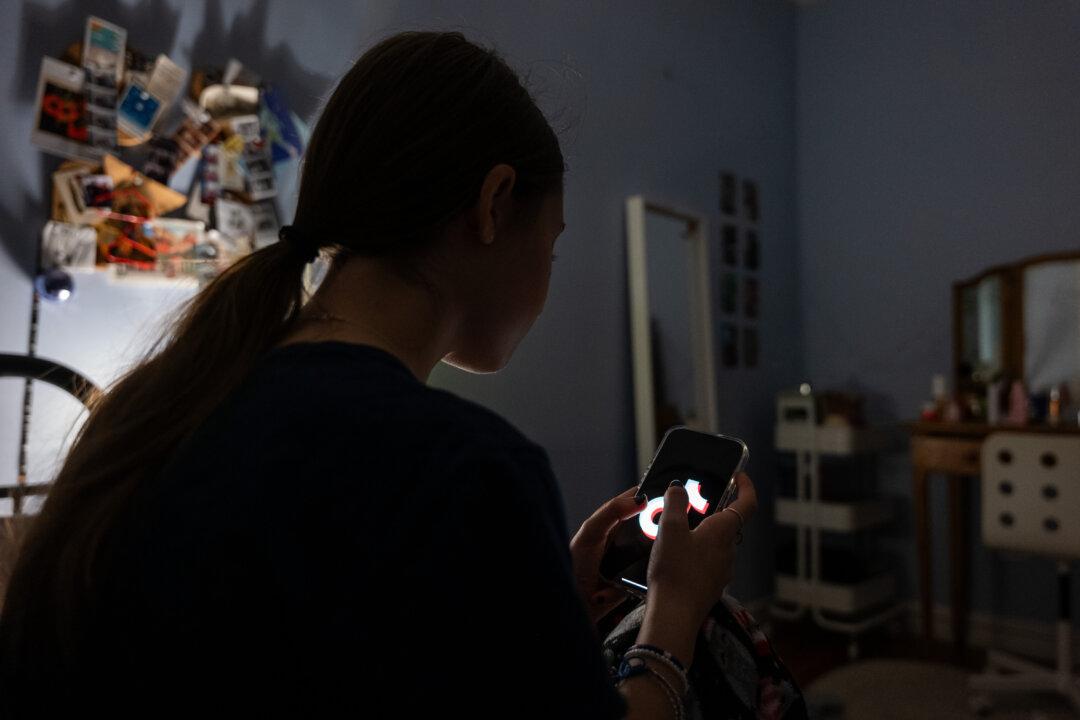In the wake of the transition to online training due to the COVID-19 pandemic, California community colleges have become overrun with “fake students, bots,” and allegations of financial aid fraud.
Kim Rich is a professor of criminal justice and the department chair for Political Science, Administration of Justice, Economics, and Chicano Studies at Los Angeles Pierce College in Woodland Hills, California. Between 2008 and 2010, Rich worked as a professor on a part-time basis, going full time in 2010.
When the COVID-19 pandemic hit in March 2020, Rich was tasked as a distance education specialist to help train faculty in the transition to online classes. The new role gave Rich greater access to student enrollment information than other faculty members.
“I have always been very good at catching cheaters,” Rich, who also has a law enforcement background, told The Epoch Times. “I have a knack for it. So, after the pandemic hit and I was tasked to do different types of training, I started to teach other faculty how to promote academic integrity, how to catch students who were cheating, and how to prevent it.”

According to Rich, many colleges use Canvas, an online, web-based learning management system for institutions, educators, and students to access and manage online course learning material. In Canvas, students have the option to customize their avatar by uploading an image or simply leaving the default avatar. To remain active and participate in online college courses, students must complete a variety of tasks such as engaging in discussions with other students, completing uploaded assignments, and taking online quizzes and tests.
However, Rich soon realized that all of the work being submitted by four students was clearly being completed by an individual who wasn’t a student in the class.
“As I looked into it further, I realized that about one-third of my class, which had about 30 students, were actually fake students,” Rich said. “In my opinion, it appears there are at least two different scams at play.
“One is where ‘fake students’ are enrolling, then likely paying someone else to do the minimum amount of work to remain ’active‘ in the class in order to qualify for financial aid. The other scam appears to involve ’bots,‘ where the person behind the scam is simply trying to register as many ’fake students’ or ‘bots’ into the system as possible so they can get in, get the financial aid, and get out. Little work is being completed by these ’bots.'”
Based upon her discoveries, Rich started looking into what classes the “fake students” had taken prior to hers. She discovered that many had taken the same classes with the same professor in the summer. Rich also realized that 11 of her new, suspected “fake students” were anthropology majors.
“That’s unheard of,” Rich said. “I don’t get 11 anthropology majors in any of my classes, which led me to believe the bots had gotten in and just picked anthropology, which is I believe one of the first majors you can enroll in going from the top of the alphabet down. That just does not happen.”
Then Rich noticed that the avatars had changed from the default to an actual image that appeared to be uploaded from the internet.
Here is the photo avatar for a suspected “fake student” claiming to be Paul Desalvo.


Here’s the profile avatar of the suspected “fake student” claiming to be Quiannia Wilson.


Here’s the profile photo of suspected “fake student” Carrie Link.




Next, Rich looked at the classes these students were enrolled in for fall 2021. The majority had at least one class in common. Many had several classes in common.
“Each time I checked a class they had in common, I found more ‘fake students’ in each of those classes, which then led to even more classes,” Rich said. “It was just a domino effect.”
She also examined student ID numbers.
“A lot of them are right on top of each other,” Rich said. “Let’s say the last two digits were 76 and then 79 or 80 then 82. They were all sequentially close and that doesn’t happen. So I started looking at more and started making numerous connections.”
Not only were all of the “fake students” in similar classes during the summer, but they’re all currently enrolled in the same fall classes.
According to Rich, the eight-week courses—known as “late-start” classes—were the catalyst to finding hundreds of fake students.
“We also have the ability to increase our online enrollment load from 40 to 80 students, which I generally don’t like to do,” she said. “But I didn’t have any more faculty in my department to teach and there was a demand, a waiting list, so I was able to get one of my faculty to agree to increase his class to 80.”
To accommodate the students on the waiting list, Rich said 40 additional spots were made available on a Monday. By that Wednesday, all 40 spots had been filled.
“That is 100 percent unheard of,” she said. “That never happens. I don’t know if that has historically ever happened for a class to fill with 40 students in less than 48 hours’ time.”
Rich began investigating new enrollees. The majority of them were fake students. A colleague asked her to look into other “late-start” classes in other departments where enrollment had also increased. She found “tons of fake students.”
“I started looking at all late starts and found that many of the fake students in ‘late-start’ classes were currently enrolled in traditional 16-week classes,” she said. “So I started to develop matrixes. I would go through one class and list all the ones I thought were fake students, and I would look at what they were taking, what they had taken, and what they were currently enrolled in, and I was linking them to other classes. I found more ‘fake students.’ It started with dozens and dozens. Then it progressed to hundreds and hundreds.”
Then Rich started to wonder: If Pierce was this infested with “fake students,” how many of the other community colleges were having the same issue? She started looking at the other colleges in the district and randomly selecting classes. Her suspicions were confirmed.
Search for Help Leads to Dead Ends
On Aug. 23, Rich contacted Dean of Student Engagement Juan Carlos Astorga by email to let him know that she had discovered that “fake students” were enrolled in their online courses.“Thanks for letting me know,” Astorga told her. “Right now, we’re dealing with a cheating scam where students hire master-level folks from Kenya and Nigeria to do all their work for the students.”
Astorga admitted that this additional issue is “district-wide,” but claims that only “nine students have Pierce as their home campus.”
“I will wait for submissions and then ask IT to run an IP address to see where they originate from,” he told Rich.
Rich told Astorga that she wasn’t concerned about who was “doing the work” for the students, but rather that the students themselves are fake and that Pierce is being used in a scam where someone is reaping thousands in financial aid.
“My point is there is something else going on beside paying others to do the work,” Rich told Astorga.
Rich emailed Patrick Luce, chief information security officer in charge of cyber security for the Los Angeles Community College District, to see if he knew what was going on and if he was investigating the problem. He never responded.
Interim Vice President of Academic Affairs Donna-Mae Villanueva was also informed of the situation. In fact, Rich had attended the monthly meeting for department chairs wherein Villanueva “mentioned how horrible enrollment was“ and how they ”needed to increase enrollment.”
According to the State Student Centered Funding Formula, which uses school size to determine the amount of funding each community college receives, Pierce stands to lose a significant amount of funding if the “fake students” are dropped from their enrollment records. Based on her own findings, Rich is convinced that if every “fake student” was dropped from fall classes currently in progress at Pierce College, enrollment numbers would be cut by one-third to one-half of the current enrollment figures.

Other Teachers Speak Out
“I care about funds being available for real students who need them,” A.J., a Pierce instructor using a pseudonym, told The Epoch Times under the condition of anonymity. “At one point I asked myself, ‘Why don’t they have IT [information technology] look at this?’“Classes are about to begin, and they’re leaving this up to us. I don’t have any tools to deal with this.”
Patrick, another Pierce educator using a pseudonym who spoke out under the condition of anonymity, said he’s also frustrated by being told it’s his job to fix the problem.
Mary, also using a pseudonym, is another Pierce instructor who spoke to The Epoch Times under the condition of anonymity.
“I noticed this semester that enrollments were very sluggish,” Mary said. “My classes weren’t being filled at the rate they normally do.”
But then, Mary said her classes were started filling up “all of a sudden.” She quickly realized a lot of them weren’t responding during online sessions and weren’t completing assignments. She started sending them emails, informing them that if they didn’t respond she would have to drop them from the course.
“And I’ve been dropping a lot of students,” Mary said.
Then she saw Rich’s presentation.
“It blew my mind,” Mary said. “I didn’t realize at the time that we were having this whole issue with fake students, and there was some talk on campus that this isn’t just happening at Pierce.
Not the First Time
On Aug. 31, the Los Angeles Times reported that the California Community Colleges system was “investigating potentially widespread fraud involving fake ‘bot students’ enrolled in active courses in what officials suspect is a scam to obtain financial aid or COVID-19 relief grants.” According to the report, a spokesman said the Los Angeles Community College District was “unaware of any problems involving applications or financial aid.”“At a minimum, the breaches represent a loss of hundreds of thousands of dollars to scammers seeking financial aid from California’s community colleges,“ EdSource reported. ”It’s possible that much more money was delivered to fake students, given that the system’s 115 traditional colleges, enrolling about 1.8 million students, are in the midst of distributing more than $1.6 billion in federal COVID relief aid.”
Pierce College, one of nine colleges in the Los Angeles Community College District, is part of the largest multi-college district in the nation.
According to Rich, Anafe Robinson, the financial aid manager at Pierce, told everyone during a special meeting for late-start instructors that the district auditor is asking for evidence of substantive activity and interaction with students within Canvas who are actively engaged. However, when someone asked if the students they knew were committing financial aid fraud had been removed, Robinson said they hadn’t.
“It’s not financial aid’s responsibility to remove them from the classes,” Robinson said when asked why the students hadn’t been removed.
The Epoch Times reached out to Los Angeles Community College District President Steve Veras, asking for a statement regarding the alleged financial aid fraud taking place at Pierce College and the allegations that the district is aware of the allegations, yet doing little to put a stop to it.
“Please note that the District is fully aware of the situation,” William H. Boyer, director of communications and external relations, told The Epoch Times. “The other allegations in your message are false, however, since the issue is under active review by the District, there is no other information we can currently share. LACCD is not alone when it comes to this issue and we recommend you reach out to the California Community Colleges Chancellor’s Office in Sacramento for a more accurate statewide perspective on the situation. Please note we take very seriously all claims and allegations of fraud or misuse of monies entrusted to us and thoroughly review all such accusations for appropriate action and follow-up.”
Astorga, Villanueva, and the innocent victims mentioned in this story, whose names and images have been used by others in an alleged effort to commit financial aid fraud, didn’t respond to requests for comment by press time.





